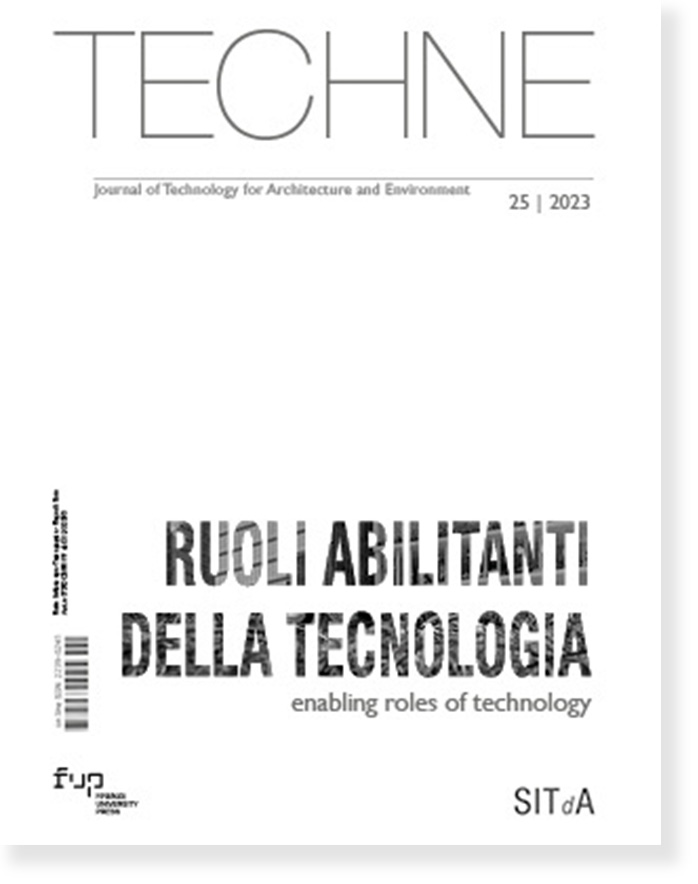Published 2023-05-30
Keywords
- Capacitating Technologies,
- User Experience,
- Living Lab,
- Advanced Simulation,
- Human Technology Interaction
How to Cite
Copyright (c) 2023 Annapaola Vacanti, Niccolò Casiddu, Claudia Porfirione

This work is licensed under a Creative Commons Attribution 4.0 International License.
Abstract
The paper describes the development of Living Hub: a laboratory for research, experimentation and training based on the Living Lab model, integrated with the use of the Simulation technique, to optimise the study of the interaction between people, environments, and technology. The lab aims to support the design of capacitating technologies and responsive environments that can adapt to the needs of their users, with reference to the home context. Located in Liguria, a region with the highest rate of ageing in the world, Living Hub focuses experimentation on innovative models for the care of the frail through different levels of scalar/modular integration of enabling technologies in the built environment.
Downloads
References
De Jong, T. (2006). Technological advances in inquiry learning. Science, 312(5773), 532-533. Available at https://www.science.org/doi/10.1126/science.1127750
European Commission. (2009). Living Labs for user-driven open innovation - an overview of the Living Labs methodology, activities and achievements. Available at https://op.europa.eu/en/publication-detail/-/publication/3f36ebab-4aaf-4cb0-aada-fe315a935eed
Floridi, L. (2022). Etica dell’intelligenza artificiale: Sviluppi, opportunità, sfide. Raffaello Cortina Editore.
Fulgencio, H., Le Fever, H., Katzy, B. (2012). Living Lab: Innovation through Pastiche. In Proceedings of the eChallenges e-2012 Conference, Lisbon: IMC (pp. 1-8). Available at https://www.academia.edu/11037703/Living_Lab_Innovation_through_Pastiche
Gaba, D. M. (2004). The future vision of simulation in health care. BMJ Quality & Safety, 13 (suppl. 1), i2-i10. Available at https://qualitysafety.bmj.com/content/13/suppl_1/i2
Giaccardi, E., Redstrom, J. (2020). Technology and more-than-human design. Design Issues, 36(4), 33-44. Available at
http://direct.mit.edu/desi/article/36/4/33/94923/Technology-and-More-Than-Human-Design
Ingrassia, P., Carenzo, L., & Santalucia, P. (2019). La simulazione ad alta fedeltà in ambito sanitario: Guida pratica e casi clinici. FrancoAngeli.
Intille, S. S., & Larson, K. (2005). Designing and evaluating home-based, justintime supportive technology. Studies in Health Technology and Informatics, 118, 79-88.
Knowles, M. S. (1968). Andragogy, not pedagogy. Adult leadership, 16(10), 350-352.
Nielsen, J. (2016). The distribution of users’ computer skills: Worse than you think. Nielsen Norman Group, 13. Available at https://www.nngroup.com/articles/computer-skill-levels/
Norman, D. A. (2008). Il design del futuro. Apogeo saggi.
Piano nazionale di ripresa e resilienza - PNNR, M6 “Salute”. Available at https://www.agenas.gov.it/pnrr/missione-6-salute
Santaera P., Severdio R., Costabile A. (2017). Anziani e depressione: il ruolo della solitudine. In Psicogeriatria vol. 3, AIP.
Siri, A., Chirico, M., Torre, G. (2017). Nuovo centro di ateneo per la simulazione: nuove opportunità di formazione e di ricerca interdisciplinare e interprofessionale. In EmemItalia 2017, Bolzano.
Spadolini, M. B., (2020). One size design. Un metodo per il progetto. Letteraventidue.
Ståhlbröst, A., & Bergvall-Kåreborn, B. (2008). FormIT: An approach to user involvement.
Traina, I. (2016). Implementing a Service of Independent Living Using a Participatory Approach. Open Access Library Journal, 3(4), 1-10. Available at https://www.scirp.org/Journal/Paperabs.aspx?paperid=69202
Wiles J., Leibing A., Guberman N., Reeve J., Allen R. (2012). The meaning of ageing in place to older people, in Gerontologist, vol. 52(3), pp. 357-366. Available at https://academic.oup.com/gerontologist/article/52/3/357/580905?login=true
Zerwas, D., & von Kortzfleisch, H. F. (2011). Potentials of living labs for the diffusion of information technology: a conceptual analysis. In IFIP International Working Conference on Governance and Sustainability in Information Systems-Managing the Transfer and Diffusion of IT (pp. 330-339). Springer, Berlin, Heidelberg. Available at https://dl.ifip.org/db/conf/ifip8-6/ifip8-6-2011/ZerwasK11.pdf






